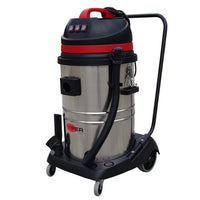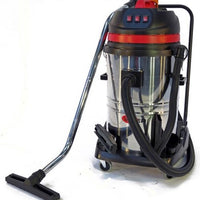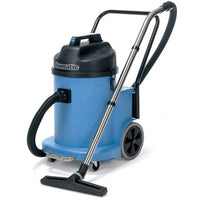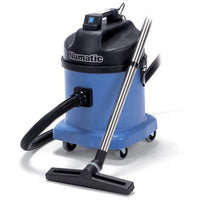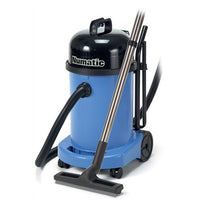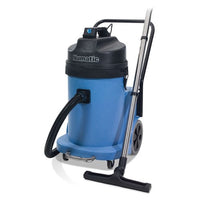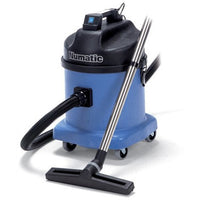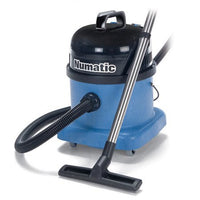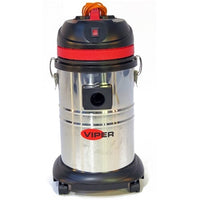Collection: Wet and Dry Vacuum Cleaners
Comprehensive range of professional wet and dry vacuum cleaners for versatile commercial cleaning. From compact units for quick spill response to industrial-capacity machines for construction sites, our selection ensures powerful performance for both liquid extraction and dry debris, maximising cleaning efficiency across all applications.
Wet and Dry Vacuum Cleaners Product information
At ClickCleaning, we supply professional wet and dry vacuum cleaners that eliminate the limitations of single-purpose machines. These versatile workhorses seamlessly transition between extracting spilled liquids and vacuuming dry debris, making them indispensable for facilities requiring true cleaning flexibility.
The ability to handle both wet and dry materials without filter changes or risk of damage transforms cleaning efficiency. Where traditional vacuums fail at the first sign of moisture and wet-only extractors cannot handle dry debris, our wet and dry machines tackle whatever challenges your facility presents. From workshop spills to construction dust, from flooded areas to routine vacuuming, these machines adapt instantly to changing requirements.
Our range spans from compact 20-litre units perfect for rapid spill response through to industrial 80-litre machines designed for continuous heavy-duty operation. Tank capacity directly influences operational efficiency - smaller units suit quick interventions and facilities with limited storage, whilst larger capacities enable extended operation in demanding environments. Stainless steel tank construction resists corrosion and impact damage, ensuring longevity even in aggressive industrial environments.
Motor power and configuration vary to match different operational demands. Single-motor machines provide adequate performance for light commercial use, whilst twin and triple motor configurations deliver the extraordinary suction power required for industrial applications. By-pass cooling systems protect motors during continuous operation, preventing overheating that plagues lesser machines pushed beyond design limits.
Filtration systems adapt to handle both wet and dry pickup effectively. Cartridge filters for dry debris remove easily for liquid extraction, whilst foam filters prevent water ingestion into motors. Advanced machines feature automatic filter cleaning systems that maintain suction performance during extended dry vacuuming. HEPA filtration options ensure superior air quality in sensitive environments, capturing fine particles that standard filters miss.
Tool compatibility extends operational versatility significantly. Our machines accept various diameter hoses and extensive tool ranges, from standard floor nozzles through specialised squeegee tools for liquid recovery. Industrial accessories include gutter cleaning kits reaching several stories high, pneumatic conveying attachments for bulk material handling, and specialist tools for unique applications.
Pump-out facilities on premium models enable continuous liquid extraction without stopping to empty tanks. These machines pump extracted water directly to drains, proving invaluable for flood recovery or large-scale wet cleaning operations. Automatic pump activation prevents overflow whilst maintaining uninterrupted operation during critical recovery tasks.
Construction quality reflects demanding commercial requirements. Robust trolleys with large wheels navigate rough surfaces and obstacles easily. Tip-resistant designs prevent accidents when tanks near capacity. Accessory storage keeps tools organised and readily accessible, improving operational efficiency. Cable and hose storage systems speed deployment and pack-up.
Power options include standard 230V operation for general use and 110V models for construction sites requiring reduced voltage for safety. Cable lengths from 10-20 metres reduce outlet changes, whilst some models offer dual power inputs for extended reach. Professional-grade cables resist damage from rough handling and environmental exposure.
Special features enhance operational capability in specific applications. Antistatic models safely vacuum combustible dusts in industrial environments. Chimney sweep functions reverse airflow for specialist applications. Power tool connections enable simultaneous dust extraction during cutting or sanding operations. These features transform basic wet/dry vacuums into sophisticated cleaning systems.
Whether responding to emergency spills, maintaining workshops, cleaning up construction sites, or providing general cleaning capability, our wet and dry vacuum range delivers the versatility, power, and reliability professional operations demand. Our experienced team helps match machines to specific requirements, ensuring optimal equipment selection for your unique challenges.
Wet and Dry Vacuum Cleaners FAQs
What's the main advantage of wet and dry vacuums over standard vacuums?
Versatility defines the primary advantage - one machine handles any cleaning challenge without equipment changes. Standard vacuums suffer catastrophic damage from liquid ingestion, whilst dedicated wet extractors cannot handle dry debris. Wet and dry vacuums transition seamlessly between tasks, invaluable when facing unexpected spills or mixed debris.
This flexibility proves particularly valuable in workshops, construction sites, and facilities where conditions change rapidly. Cleaning crews carry single machines rather than multiple specialists, improving efficiency and reducing equipment investment. The ability to handle emergencies immediately prevents permanent damage from spills.
Robust construction suits demanding environments where standard vacuums fail. Stainless steel tanks resist impact and corrosion, whilst powerful motors handle continuous operation. Investment in quality wet/dry vacuums often proves more economical than maintaining separate wet and dry machines.
How do I choose the right size wet and dry vacuum?
Tank capacity selection balances operational efficiency against practical handling. Our 20-30 litre machines suit rapid deployment for spills, detail cleaning, and facilities with limited storage. These compact units remain manoeuvrable when full whilst providing adequate capacity for most tasks.
Medium 35-55 litre machines represent the commercial sweet spot, offering extended operation without excessive bulk. These sizes handle most applications effectively, from workshop maintenance to emergency response. Larger 60-80 litre industrial models maximise efficiency in extensive facilities but require consideration of handling when full.
Remember that liquid weighs approximately 1kg per litre - an 80-litre machine at capacity weighs over 100kg including the machine. Pump-out models eliminate this concern by continuously evacuating liquid. Match capacity to typical applications and operator capabilities.
What's the difference between single and multi-motor machines?
Motor quantity directly impacts suction power and operational capability. Single-motor machines provide adequate performance for general cleaning, light industrial use, and facilities with moderate demands. These economical options balance performance with purchase and operating costs effectively.
Twin-motor machines deliver substantially increased suction, beneficial for heavy debris, long hose runs, or simultaneous dual-operator use. The additional power proves valuable in industrial settings where maximum performance matters more than operating costs.
Triple-motor configurations represent maximum available power, essential for extreme applications like flood recovery or industrial bulk handling. However, power consumption and noise levels increase proportionally. Evaluate whether your applications genuinely require maximum power or whether efficient single-motor machines suffice.
Can wet and dry vacuums handle hazardous materials?
Standard wet and dry vacuums suit general debris and non-hazardous liquids but require specialised models for hazardous materials. Type H (hazardous) certified machines feature absolute filtration, sealed construction, and safe disposal systems for harmful dusts like asbestos or lead paint.
Type M (medium hazard) machines handle wood dusts and similar materials requiring good but not absolute filtration. Type L (light hazard) suits general construction dusts. Using incorrect machines for hazardous materials risks serious health consequences and legal liability.
Chemical compatibility requires careful consideration - standard machines handle water-based liquids but not solvents or corrosives. Specialist chemical-resistant models feature appropriate seals and tank materials. Always verify compatibility before vacuuming unknown substances.
How important is filtration in wet and dry vacuums?
Filtration critically impacts both performance and safety. Basic foam filters suffice for wet pickup but provide minimal dry filtration. Cartridge filters deliver good dry performance but must be removed for wet operation. Advanced machines feature separate wet and dry filters, eliminating changeover delays.
HEPA filtration captures 99.97% of particles above 0.3 microns, essential for fine dusts and environments requiring superior air quality. Self-cleaning filters maintain performance during extended dry vacuuming through automatic pulse cleaning. This feature proves invaluable in dusty environments.
Filter maintenance directly affects performance and motor life. Clogged filters strain motors and reduce suction dramatically. Regular cleaning or replacement according to conditions ensures optimal performance. Budget for replacement filters as operational consumables.
What accessories are essential for wet and dry vacuums?
Floor tools adapted for wet and dry pickup prove fundamental. Combination tools feature squeegee blades for liquids and brush strips for dry debris. Dedicated squeegee tools excel at liquid recovery, whilst brush tools improve dry pickup on carpets.
Crevice tools access tight spaces common in industrial environments. Extension tubes enable high reach and improve ergonomics. Specialty tools like turbo brushes enhance carpet cleaning, whilst gulper tools handle large debris efficiently.
Consider your primary applications when selecting accessories. Facilities focused on spill response benefit from wide squeegee tools and pump-out kits. Construction applications require robust tools handling rough debris. Purchasing complete tool sets often proves more economical than individual acquisitions.
Are stainless steel tanks worth the extra cost?
Stainless steel tanks cost approximately 30% more than plastic but deliver significant advantages. Corrosion resistance ensures longevity when handling various liquids, whilst impact resistance survives industrial abuse that cracks plastic tanks. Stainless steel also resists chemical attack from cleaning agents.
Hygiene benefits make stainless steel essential in food service and healthcare. The smooth surface cleans thoroughly
and doesn't harbour bacteria in scratches. Professional appearance matters in customer-facing environments where equipment visibility impacts perception.
Plastic tanks suit light commercial use where cost matters most and conditions remain benign. However, calculate total
ownership costs - stainless steel tanks often outlast multiple plastic replacements, proving more economical long-term in demanding applications.
What safety features should I prioritise?
Float valves preventing motor damage from overfilling rank as essential safety features. Quality machines incorporate
reliable mechanical floats that shut off suction before liquid reaches motors. Electronic sensors provide additional protection but shouldn't replace mechanical systems.
Antistatic features prove crucial when vacuuming combustible dusts. Conductive hoses, grounded components, and antistatic filters prevent dangerous static buildup. These features are mandatory for certain industrial applications, not optional extras.
Electrical safety includes appropriate insulation, circuit protection, and strain reliefs preventing cable damage. Thermal overload protection prevents motor damage from extended operation. Stability features like low centres of gravity and wide wheelbases prevent tipping accidents when tanks approach capacity.
How do pump-out systems work?
Pump-out systems enable continuous liquid extraction by automatically evacuating tank contents to drains. Float switches activate pumps at preset levels, maintaining operation without manual intervention. This proves invaluable during flood recovery or large-area wet cleaning.
Pump specifications determine evacuation speed and head height capability. Quality pumps handle 100-200 litres per minute and pump vertically several metres. Automatic operation frees operators for active cleaning rather than tank monitoring.
Investment in pump-equipped machines pays dividends in appropriate applications through eliminated downtime and improved productivity. However, simpler machines suffice for occasional wet pickup. Evaluate frequency and volume of liquid handling when considering pump options.
What maintenance do wet and dry vacuums require?
Post-use cleaning proves crucial, particularly after wet pickup. Empty and rinse tanks thoroughly to prevent odours and corrosion. Dry all components before storage to prevent mould growth. Clean filters according to debris type - fine dust requires more frequent attention than coarse materials.
Regular inspection identifies developing issues before failure. Check hoses for damage that reduces suction. Inspect
seals and gaskets for wear that might cause leaks. Verify float operation by testing with water periodically. Replace worn components promptly to maintain performance.
Professional servicing annually addresses motors, switches, and internal components beyond routine maintenance. This preventive approach costs far less than emergency repairs whilst ensuring reliability. Maintain service records for warranty compliance and resale value.


